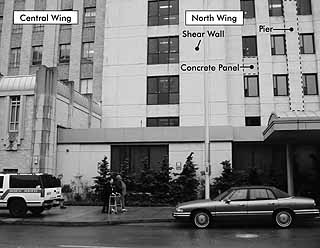
DJC.COM
August 25, 2005
Harborview wing getting a second skin
Magnusson Klemencic Associates

Anderson
|

Hooper
|
Seattle's Harborview Medical Center is a critical community resource and the only regional Level I trauma center in a five-state area.
To retain that status, the Harborview bond program calls for a seismic upgrade of the hospital's North Wing, designed in 1973. The North Wing houses critical emergency services and will serve as a vital physical link between the existing West Hospital and the new Inpatient Expansion Building.
The performance of the North Wing in an earthquake therefore has to be consistent with the performance of newer construction, requiring an update to current seismic codes.
4 goals
When engineers at Magnusson Klemencic Associates began the structural design for the seismic upgrade, the following goals were established:
— The building shall allow for "immediate occupancy" following a design-level earthquake (with immediate occupancy defined as minimal post-earthquake damage and disruption, with some repairs and cleanup done while the building remains occupied and safe).
— The seismic upgrade must be accomplished without closing off major portions of the building.
— Disruption to the critical functions within the building must be minimized during construction.

Photo courtesy of MKA
Sheets of fiber-reinforced polymer will be applied to Harborview's exterior to improve its earthquake resistance. The technique is less intrusive than more traditional approaches.
|
— An economical design solution — within the current bond budget — must be provided.
Seismically upgrading a busy trauma center while it remains completely operational presented a significant challenge.
Stiff building, delicate panels
The earthquake-resisting system in the North Wing consists of concrete shear walls around the elevator core and perimeter concrete walls.
The perimeter walls have 14-inch-thick vertical piers between the windows and 6.5-inch-thick concrete panels stacked on top of the windows, spanning between the vertical piers.
A computer analysis of the North Wing revealed that the building is very stiff (it wouldn't move much in an earthquake), but the thin concrete panels are at risk of cracking, yielding and losing strength during an earthquake.
A traditional upgrade approach would be to add new structural elements for necessary seismic resistance. However, since the North Wing is already very stiff, new structural elements would have to be even stiffer than existing elements, or the existing perimeter wall would need to fail for the new elements to become effective. In addition, new structural elements, with associated foundations, would be prohibitively expensive and very disruptive to building occupants.
Solution at hand
After considering several approaches, the engineers determined that the application of fiber-reinforced polymer (FRP) directly to the surface of the existing concrete presented many advantages.
FRP is a high-strength glass or carbon fiber fabric that is adhered to a concrete surface with an epoxy binder. FRP is becoming increasingly common in repairing and reinforcing existing concrete elements.
Locally, FRP has been used on several high-profile projects, including the Alaskan Way Viaduct and the University of Washington's Suzzallo Library upgrade.
FRP appeared to be a very attractive method of reinforcing the concrete panels above and below the windows of the North Wing because it could be applied to the exterior of the building with minimal disruption to occupants. In addition, the FRP would provide reinforcement to existing elements without changing the building's overall seismic behavior.
It would be important, however, to monitor the concrete panels as they were reinforced with FRP so they did not become too strong and force cracking or yielding in the vertical piers. The goal was to increase the ability of the concrete panels to maintain their strength even if the concrete cracked and the reinforcing steel began to yield.
A computer analysis was performed to simulate the seismic performance of the North Wing with an FRP upgrade. The computer modeling requires that the properties of the building elements with the new reinforcement be defined and quantified with the development of cracking and yielding in order to evaluate the overall stability of the building.
However, design guidelines for FRP reinforcing, developed by the American Concrete Institute, address strength requirements but not post-cracking or yielding performance. While FRP reinforcing appeared to have many advantages, the post-cracking and yielding performance needed to be verified and quantified.
Testing and more testing
Mock-up concrete panels were constructed and tested at UW's civil engineering department. Panels were tested in an as-built condition, then with FRP applied in various configurations to determine optimum reinforcement.
Initial tests applied a sheet of FRP over the entire surface of the concrete panel. FRP bonded well to the surface of the concrete, but once the concrete panel began to crack, the surface fractured off with the FRP sheet.
Once the FRP sheet and concrete surface began to pull away, the entire sheet would pull off suddenly like a zipper. While the FRP reinforcement did increase strength, the sudden failure mode was undesirable.
The second round of tests replaced the full sheet of FRP with individual strips separated by bare concrete. Speculation was that the strips would stop the zipper effect.
In these tests, each strip of FRP behaved independently, but once a strip began to pull away from the body of the panel, the entire strip would lose effectiveness. The strips provided better post-cracking and yielding performance, but not yet as desired.
The next round of tests added FRP anchors, which provided a shear connection between the FRP strips and the body of the panel.
With the addition of the anchors, the tendency of the FRP to pull away from the surface of the panel was limited to the length of strip between the anchors. By varying the location of the anchors, the engineers were able to tune the performance of the FRP reinforcement.
A model building
Once the material properties of the FRP-reinforced concrete panels were determined, the final step was to apply the properties to the computer model to verify performance and post-earthquake stability.
The computer analysis demonstrated that following the cracking and yielding in the structure, the existing (non-FRP-reinforced) structure lost strength, which could lead to progressive failure of the building.
However, with the application of FRP reinforcement, the structure was able to maintain its capacity to carry earthquake forces well after the onset of cracking and yielding — essential for an "immediate occupancy" structure.
FRP will be applied to the North Wing once the new construction phase is complete. After the FRP is applied, an architectural finish will be adhered to the exterior and painted.
The order from Harborview to provide an economical seismic upgrade with minimal disruption to occupants seemed impossible. However, through optimized application of FRP reinforcement, verified by material testing and computer simulations, Harborview's performance goals will be satisfied.
Bob Anderson and John Hooper are principals at MKA, and active in the firm's Healthcare Specialty Group.
Other Stories:
- Creative site selection opens doors
- Retailers have a role in health care system
- Hospitals have been slow to try green building
- Can't fund your building project? Try private capital
- Silence is golden — but rare — in a hospital
- Equipment issues complicate health care projects
- Reaping the benefits of better design
Copyright ©2009 Seattle Daily Journal and DJC.COM.
Comments? Questions? Contact us.